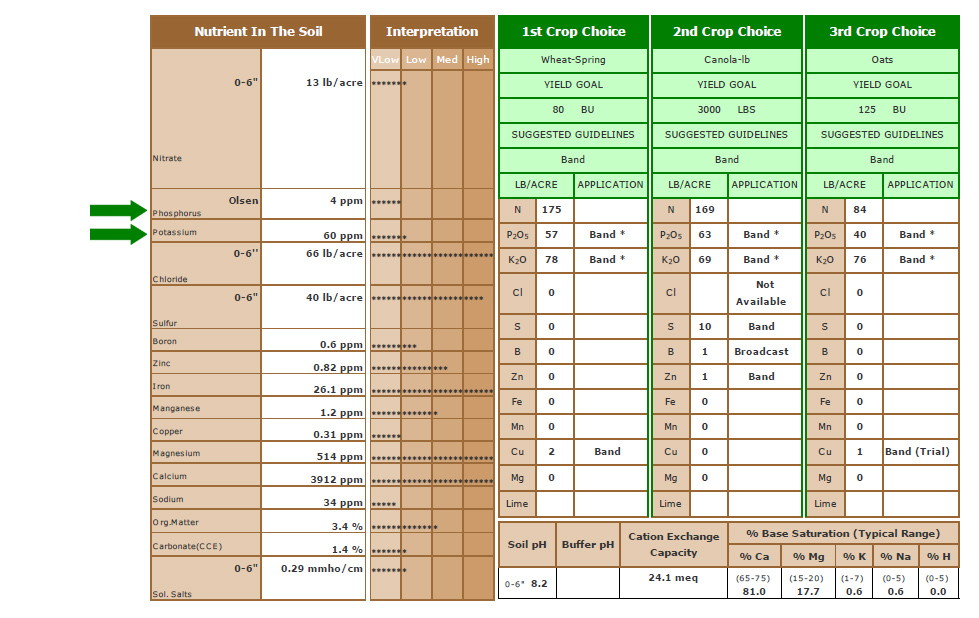Farmer Asks How To Improve P and K On Rental Ground

A farmer in Roseau County, Minn., rented some new ground this year and sent his soil sample test results to Ken Ferrie, asking how to improve upon the nutrient levels and improve crop performance. Here are some of the primary questions the grower asked and how Ferrie, Farm Journal Field Agronomist, responded. Some light editing was done for clarification.
Farmer Question:
“I picked up some new ground this year, and I did the soil test on it last fall. As you can see from the soil test results here, it has very low phosphorus (P) and potassium (K) levels and high soil pH. The calcium and magnesium levels are high. Do you think these ratios work against getting plants to uptake phosphorus and potassium? I plan to band P and K, since this is rented ground. Is there anything else that can improve soil like this, in your opinion?

 Ken Ferrie's Answer:
Ken Ferrie's Answer:
There's not a lot of information we know about this piece of rental ground beyond what you’ve mentioned. But based on your soil test results, and the 4Rs of fertility, I think you’re on the right track. My short answer is I’d recommend banding your phosphorus (P) and potassium (K) and then broadcast some additional K, because I think you'll be able to build a potassium value in that soil test.
Here are some additional thoughts Ferrie shares to support his recommendations:
With the 8.2 soil pH level you’re working with, it’s really unlikely you’ll be able to raise the P value, per se. I’d recommend that you band all of your phosphate and do that more on a yearly basis. I think that will give you better results.
In most scenarios I see here in Illinois, phosphate levels go up fairly easily and come down slowly. But in your case, all of the phosphate is being fixed to calcium. That’s why I think you would be better off to apply all of your phosphate in the spring in a band.
I see you’re running the Olsen test, but even if you used the Bray 1 or Bray 2 tests they would show that you’ve got a lot of phosphorus tied up with all the calcium that's in that soil. It’s nothing you’ve done, it’s just the result of where the ground is located and the soil type there.
I think you also may want to increase your potassium applications, as your potash value is low. I would band my potash initially and then broadcast higher amounts of K because I think you’ll be able to build a potassium value that you’ll see in the soil test. The potash value will go up over time, if you apply more potash to the system. Do keep in mind that potash levels are usually slow to go up and fast to come down (just the opposite of phosphorus).
Consider Tissue Testing
I don't know that much about canola, oats and wheat, as far as micronutrients go. My suggestion would be that you look at some tissue tests during the growing season this year to make sure your zinc, sulfur and boron levels are where you need them to be.
You do have a decent level of sulfur in that soil, which is a bit surprising. But that might simply be a reflection of the soil makeup in your area – meaning that it's probably what we would call a younger soil compared to, let's say, the soil types in southern Illinois.
Sulfur may not be an issue for you, but I would likely be adding some sulfur to the mix. Sulfur is a tough one to test for. I'm going to assume – which we all know what that means – that you’re checking for sulfate levels in the soil. That can be a lot like nitrates, high during one part of the year and low the next part. So, a sulfur reading on a soil test doesn't mean that much. I would likely be making a sulfur application on that wheat as well as the canola.
5 Trends To Watch In The Input Market
Two Important Factors For Fertilizer Prices This Spring
Shockingly Cool: This Startup Makes Fertilizer From Electricity
David Hula Hit Another New Record Corn Yield With 623 BPA, Now Thinks 900 BPA Is Possible







